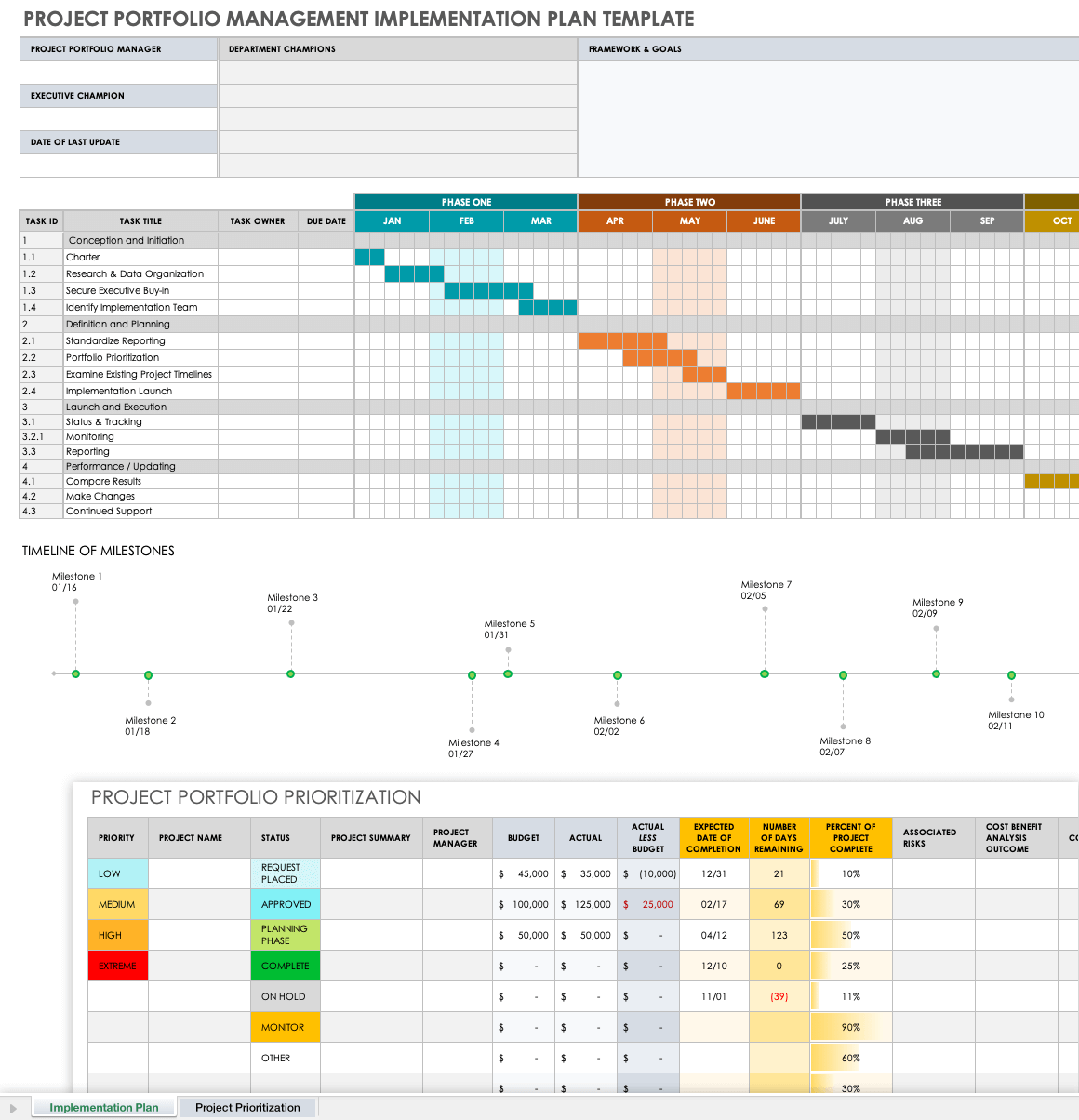Project Portfolio Management Implementation Process
The project portfolio management (PPM) implementation process is an organizational endeavor. The company establishes an action plan and a framework for governance, then standardizes new practices around those elements. To implement PPM successfully, you must drive change at all levels.
“Operationally, most organizations focus their efforts on project selection, governance, and oversight. Project selection is the process of reviewing project requests or proposals and deciding which projects to pursue based on strategic alignment, return on investment, or other enterprise-specific factors. Governance and oversight are the processes for creating standardized delivery patterns, reporting on project performance, and taking corrective actions when necessary,” says Alan Zucker, Founding Principal of Project Management Essentials.
Project portfolio management is an effective governance tool for the coordination and management of many projects. To learn more about PPM, read this guide to project portfolio management.
Project and Portfolio Management E-book
Feel like work is moving faster than ever? It is.

In this introduction to project and portfolio management (PPM), learn how to streamline your efforts and get multiple projects — or an entire portfolio — over the finish line, on time and on budget.
How to Implement Project Portfolio Management
Project portfolio management is a philosophy with no single, universal methodology; however, all implementation approaches require buy-in from the entire organization, adherence to the chosen framework, and careful consideration of the company’s goals and values.
Some managers take a straightforward, single-goal approach to portfolio management, while others prefer the versatility that comes with Agile approaches. Your first goal is to find the right fit for your company.
“When it comes to project portfolio management, you have a single objective: to identify and improve the returns on a project. Identifying an approach should stem from the questions you have regarding the project under consideration, whether [they are questions of] productivity, quality, or overall cost-effectiveness. When you have your purpose in mind, identifying areas for improvement and amplification becomes apparent,” says Alex Mastin, Founder and CEO of Home Grounds.
To outline your approach to portfolio management, first define your goals: “Get very clear on goals upfront,” suggests Jake Carroll, Founder of Create Kaizen. He continues, “Make sure goals, reporting requirements, etc., are clear from the beginning — making even a small change to these [considerations] could drastically alter how you report portfolio management.”
In addition, your company’s mission (as well as its size and industry) factors heavily into the way you manage your portfolio. Your company’s willingness to adapt to change is yet another factor that helps determine your approach to PPM. Moreover, you must choose an approach that makes your time frame and other goals reasonable and, therefore, achievable.
Ensure early on that all team members are on board with your approach. The best way to do this is to identify a champion for your process who is a leader in the business. If you have executive support, the rest will soon follow. It is also essential to secure support from other departmental leaders and managers, as portfolio management requires consistent, standardized processes. If one team is doing things differently, your approach will be much more difficult to implement.
“Every organization configures its portfolio management practices somewhat differently. Small companies may have a single portfolio, whereas large corporations may have many. Typically, a senior manager should lead the portfolio management team. The team may be within the finance, planning, or technology department, but members should always report to a senior leader,” recommends Zucker.
Establish a framework for your project portfolio management approach that emphasizes what your business values most. Set a timeline for prioritization, and understand that you may need to continually revisit prioritization of the same projects as time goes on. The framework should outline the most important goals you have for portfolio management, and you should make all decisions with that framework in mind.
Six Project Portfolio Management Implementation Steps
Project portfolio management requires six steps to implement. First, you must define your approach and secure executive support. Next, bring your plan to the team. Then, gather portfolio data and prioritize it. Finally, monitor and manage your portfolio.
Step 1: Define Your Project Portfolio Management Approach
Define your project portfolio management approach by determining your company’s goals, establishing your framework, and analyzing your company’s willingness and ability to change in order to create a realistic timeline for your work.
“The first step is to decide what is important to the organization in terms of selecting and overseeing project execution. The second is to design and implement a basic process that meets those minimal needs. Use paper-based or lightweight tools to implement the first iteration of the process because you want to be able to implement updates or changes to the process quickly, as you learn,” says Zucker.
Step 2: Secure Executive Support for Your Project Portfolio Plan
Organizational changes require strong support and examples from leadership. Ensuring that your executives are on board with new practices is the best way to encourage others to join in.
Step 3: Secure Team Support for Your Project Portfolio Plan
Once you have executives on board, reach out to other management and departmental leaders to bring them on. Project portfolio management affects all projects and teams, so you must establish early precedent to ensure you meet new standards across the company.
Step 4: Gather Portfolio Data
Create a comprehensive list of the company’s current and potential projects. Make sure you have data on those projects, such as timelines, milestones, potential risks, resource needs, and ROI.
Step 5: Prioritize Your Project Portfolio
Prioritize the projects based on your framework. You might choose to favor projects with higher ROI regardless of risk, or you may prefer a more risk-averse approach. Whatever approach you choose, be objective, keeping company goals in mind.
Step 6: Learn and Evolve from Your Project Portfolio
Situations change over time, and so do portfolios. It is essential to evaluate your portfolio on a recurring basis to ensure that your current framework and approach continue to align with the goals of the company.
Don’t be afraid to make changes when needed: “After you have gained some experience with the process, evaluate it. Solicit feedback from senior leaders, management, and project teams. Are the ‘right’ projects being selected? Is the process transparent and lightweight? Based on the feedback, adjust where needed,” recommends Zucker.
Read this guide to the project portfolio management process, steps, and flows to learn more about portfolio management after implementation.
Project Portfolio Management Implementation Strategy
Build your implementation strategy to offer the best results in the most reasonable amount of time possible. Allow for some flexibility to accommodate multiple departments with different deliverables, but be sure to retain the same fundamental approach.
Organize your portfolios using consistent ranking criteria across the board. Make sure you report the same information and hold the same key meetings regarding all potential and ongoing projects.
Project Portfolio Management Implementation Roadmap
An implementation roadmap is a simplified, easy-to-read version of your implementation plan. Define your approach, secure executive support, get the team on board, gather project information, organize and prioritize those projects, and continuously evolve your approach as needed.
Project Portfolio Management Implementation Costs
The ultimate goal of project portfolio management is to make improvements in processes that are more valuable than your costs.
These costs are not just financial; they might include training, software, and time investment. However, the benefits of successful implementation are increased project success, better ROI, and increased efficiency.
Pat Khumprakob, an independent IT product and innovation consultant, shares his experience concerning the cost of implementing project portfolio management: “The costs are huge, especially for organizations that are heavily regulated or have been operating in a set manner for a long time. While there are costs associated with bringing in new staff, I see bigger costs regarding changing existing staff to fit new models.”
Khumprakob adds, “A lot has changed in technology over the past 20 years, and asking tenured employees to adapt to things like Agile, dev ops, design thinking, and more can make them feel very uncomfortable. They're used to a system where, if they do their work, make it bug-free, and deliver on time, they get their bonuses and raises. Trying something new puts that reward system directly in jeopardy.
“A lot of costs come back to change,” Khumprakob continues. “How do we encourage change in existing employees, processes, systems, and more in order to adapt to new practices and techniques? How do we coach, train, and mentor staff to understand the ecosystem, while still letting them bring their fresh views or years of expertise to the table? It's very tricky.”
Khumprakob says, “I was with a company that brought me in to build up a digital product organization from the team level. When I started the job, I quickly found out that there was no support at the top levels for this initiative. Business and IT weren't aligned (and this was an IT initiative); there was no leadership direction or mindset in place, and it turned into a nightmare. Skilled employees quickly left because they realized the infrastructure for success wasn't in place.
“When you implement a new management structure, you have to start at the top with someone who has the vision, direction, and influence to bring other leaders on board. From there, you can start looping in or recruiting top talent to drive the vision. Then, you follow that step by including junior talent, who you can coach and mentor.
“When done right, a new management structure can deliver great results. When done poorly, it can cost more than just a couple of key hires,” Khumprakob concludes.
To learn more about the benefits and challenges of PPM, read this comparison of the pros and cons of project portfolio management.
Project Portfolio Management Implementation Plan Template
Download Project Portfolio Management Implementation Plan Template
Microsoft Excel | Google Sheets | Smartsheet
You can use this template to organize the implementation of your portfolio management plan. Use it to outline your goals and framework, identify your key team members, and easily list and organize your project portfolio.
Check out this template page for more free project portfolio management templates.
Project Portfolio Management Implementation Challenges
Project portfolio management implementation can be a difficult and complicated process. Portfolio managers must overcome many challenges, from hiring new staff to training the team on new procedures and organizing and prioritizing existing projects and data.
Here are the main challenges you face when implementing project portfolio management:
- Securing Buy-In: Securing buy-in from both executives and department or project managers can be difficult. You must bring together different management requirements and styles in a way that satisfies the needs of all. “Implementing project portfolio management comes with the growing pains of rollout. Make sure to clearly state what the operational toll will be on key stakeholders and get buy-in before implementing,” warns Carroll.
- Using a One-Size-Fits-All Approach: All projects are different, so removing nuance in the management and prioritization process can produce both positive and negative results. Ensuring that your prioritization framework truly reflects your business values can help to enhance the positive and reduce the potential for the negative.
- Training and Restructuring: Hiring and training is expensive. New project portfolio management strategies may require you to hire new portfolio managers and will definitely require training existing department project managers on all new procedures.
- Knowing Your Limits: Understanding the limits of your resources and your team is critical when implementing project portfolio management. “You need to know where you can stretch your resources and where you need to withhold. Your revenue depends not just on how long a project lasts, but also on the amount of resources you invest in it. Variables are a part of business, and your resources can be variable. Staying adaptable and open to change is very important,” says Mastin.
- Dealing with Complexity: “It is very easy to get in over your head when implementing project portfolio management by creating a complex system that's more work to maintain than it's worth. This problem is twofold: One, you obfuscate your data and findings, which leads to poor decision making; two, you lessen the perceived importance of portfolio management within your company. Project portfolio management is a very powerful tool, but poorly informed decision making can lead to a long, tough road to adoption and recovery,” Carroll admonishes.
- Gathering Data: When starting fresh with project portfolio management, you have a huge amount of data to collect and organize, all likely in different formats with different naming structures on different servers across different departments. “Analyze the data over a period of time before making any decisions. One of the mistakes most project portfolio management initiates make is jumping the gun on the decision making. Patience is rewarded with more calibrated results. You need to identify the long-term benefits to ensure the longevity of the business,” notes Mastin.
- Confronting Changing Project Priorities: Managing projects under a new model is difficult. For example, if you’re currently managing several projects in progress when executives decide to assign a higher priority to other projects, you may find your once high-priority projects postponed or dropped completely.
- Shouldering the Costs in Money and Time: Project portfolio management implementation is expensive in terms of both money and time. Planning and gathering data, hiring and training new staff, paying their ongoing salaries, spending the time to switch processes, and making investments in new software are all examples of the costs associated with implementation.
| Challenges | Solution |
|---|---|
| Securing buy-in | Start at the executive level. Early high-level buy-in encourages lower-level and interdepartmental cooperation. |
| Adopting a one-size-fits-all approach | Ensure that your prioritization framework truly reflects the needs and goals of your company. Doing this allows the best projects to come out on top and, thus, guarantees that you spend resources in the most efficient way. |
| Training and restructuring | Hiring, training, and restructuring are expensive, but necessary components of project portfolio management implementation. Putting a solid implementation plan in place and ensuring cooperation from all departments can help minimize these ongoing costs. |
| Knowing your limits | Understanding the limits of your resources and team takes experience and skill. Closely monitor ongoing projects to ensure that you are not pushing your team beyond what it can successfully accomplish |
| Gathering data | Implement a company-wide naming and storage structure for projects and reports, regardless of department. Doing this helps you keep projects and reports organized and accessible. You should also create a standardized reporting system, so you can compare certain KPIs across projects. |
| Confronting changing project priorities | Start the implementation process slowly, and if possible, wait until any major projects are finished before launching any large-scale changes. Begin new reporting and prioritization procedures when new projects commence, rather than implementing these procedures when projects are already in progress. |
| Shouldering the costs in money and time | Project portfolio management implementation is, in itself, a large-scale project. Estimate the costs and resources you need for implementation just like you would any other project, and make sure that your budget allows for all necessary resource use and expenses. |
Tips for Implementing Project Portfolio Management
You can use many strategies to ensure the successful implementation of portfolio management, from creating a detailed plan to facilitating visible and open communication. Below, you’ll find a list of expert advice:
- Create a Detailed Plan: Put together a detailed implementation plan with a framework that reflects your business goals. Give your plan a chance to work, but don’t be afraid to change things when needed.
- Facilitate Visibility and Open Communication: From the outset, educate everyone involved regarding the nature of the plan, and during implementation, keep progress visible.
- Establish an Implementation Team: Choose multiple champions at multiple levels in multiple departments who all report to one executive leader. Check in often and make sure things are on track.
- Use Available Software: Choose a project portfolio management software tool that complements your approach. “There are many stories you can make data tell, and the infrastructure your project portfolio management tooling takes on will reflect the eventual data you get from [that infrastructure]. Do your research and choose the tool that will bend to fit your team and process, not the other way around,” offers Carroll.
- Leverage Existing Company Culture: Take a look at your company’s existing processes and culture, and create a plan that works within that structure. “When implementing a project portfolio management program, it is important to understand the organizational and cultural context. Many new programs fail because they establish practices that are out of context. Successful programs establish clear business goals based on the existing culture. Then, these programs establish processes and practices that begin moving the organization in the new direction,” Zucker observes.
- Keep It Simple: Project portfolio management is a complex process that can quickly become unwieldy. “Solve for the easiest, most flexible ways to serve your use cases. Keep it simple. Tooling and process can quickly get complicated, so to ensure agility over time, remember that simpler is better,” suggests Carroll.
- Organize: Organize all existing project data, and create a naming and organization structure for storing data and referencing projects in the future.
- Automate as Much as Possible: The more you can automate project portfolio management reporting for a product manager or team lead, the higher the quality of your data will be; the better the data, the more you can trust the insights you glean from that data.
- Make Adjustments Where Necessary: Give things a chance to work, but know when to make changes. “Tool and process rollouts seldom go as planned, so make sure you establish touchpoints early and often. That way, you can get feedback, so you can pivot while things are still flexible,” Carroll points out.
- Support Your Teams: Your team is one of your most valuable resources, and it only grows more experienced and valuable over time. “One of our core principles is ‘fund the teams, rather than the project.’ This means that we fund the project delivery teams and then decide which teams should execute which work or projects. This practice reduces the churn of forming and disbanding our project teams. Lightweight project portfolio management processes allow you to prioritize projects quickly. When the teams complete one project, you assign the next project (that is, the one at the top of their prioritized stack),” explains Zucker.
Project Portfolio Management Implementation Case Study
Blackboard, an enterprise software giant in the education industry, needed a tool to help it organize and manage its numerous project portfolios.
With thousands of users, each of whom had their own unique needs and challenges, Blackboard needed a solution that was easy to use and implement across numerous diverse ecosystems. The company chose Smartsheet as the software to meet its needs.
Before adopting Smartsheet, the team had trouble with large-scale project portfolio management. The customer story includes the following testimonial from David Minutella, PMP, Senior Manager of Client Services at Blackboard Transact:
"We were sending a lot of email back and forth and working from Excel documents. It was really complicated and difficult to manage version control in that tool," he says. "This problem was giving the client an impression of unprofessionalism."
Implementing Smartsheet as a project portfolio management tool gave Blackboard the power to make two critical improvements: one, the company was able to better establish expectations with potential customers; and two, it was able to provide existing and ongoing customers with better visibility into project processes (throughout the lifespan of a project).
Since making these two changes, Blackboard has been better equipped to distribute workloads regarding numerous clients and has been able to improve visibility for key stakeholders. The company is saving thousands of meeting hours a year by collecting updates and progress reports in one place in real time.
As a result of improving these processes, the company now presents a more professional face to potential customers and, in turn, generates higher sales and adoption of its own platform.
To learn more about enterprise PPM, read this complete guide to enterprise project portfolio management.
Improve Collaboration and Increase Work Velocity with Project Portfolio Management in Smartsheet
From simple task management and project planning to complex resource and portfolio management, Smartsheet helps you improve collaboration and increase work velocity -- empowering you to get more done. The Smartsheet platform makes it easy to plan, capture, manage, and report on work from anywhere, helping your team be more effective and get more done. Report on key metrics and get real-time visibility into work as it happens with roll-up reports, dashboards, and automated workflows built to keep your team connected and informed. When teams have clarity into the work getting done, there’s no telling how much more they can accomplish in the same amount of time. Try Smartsheet for free, today.




